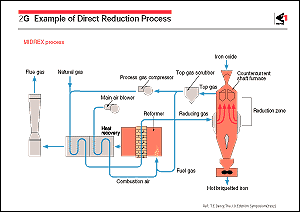Direct-reduced iron (denoted DRI
hereinafter) is obtained when fine ore and lump ore are reduced
in a solid state at the relatively low temperature of about 1,273K
(1,000 ) using reformed natural gas. The methods
now used include the FIOR, FINMET and CIRCORED processes and
IRON CARBIDE process, all of which reduce fine ore in a fluidized
bed; the HYL-I process, and HYL-II process, which use a retort
bed, and the Midrex process and the HYL-III process, which use
a countercurrent shaft furnace to reduce pellets and lump ore,
and others. Of these, the Midrex, HYL-I and HYL-III processes
have been successfully industrialized in large scale production.
The Midrex and HYL-III processes are now most commonly used for
direct reduction, the former having the largest manufacturing
share. Production of DRI totaled 31 million tons in 1995. ) using reformed natural gas. The methods
now used include the FIOR, FINMET and CIRCORED processes and
IRON CARBIDE process, all of which reduce fine ore in a fluidized
bed; the HYL-I process, and HYL-II process, which use a retort
bed, and the Midrex process and the HYL-III process, which use
a countercurrent shaft furnace to reduce pellets and lump ore,
and others. Of these, the Midrex, HYL-I and HYL-III processes
have been successfully industrialized in large scale production.
The Midrex and HYL-III processes are now most commonly used for
direct reduction, the former having the largest manufacturing
share. Production of DRI totaled 31 million tons in 1995.
The Midrex process is shown in the figure. Reforming natural
gas has a H2/CO ratio of 1.6, the
temperature is 1,173K (900 ), the in-furnace pressure
of the countercurrent shaft furnace is 100 kilopascals, and the
energy necessary for reduction is 10.5 gigaJoules/ton-DRI. Part
of the exhaust gas is mixed with natural gas and reformed, and
the remainder is used as the fuel for the reformer furnace. In
the HYL-III process, the H2/CO of
the reformed gas is 3, the temperature is 1,203K (930 ), the in-furnace pressure
of the countercurrent shaft furnace is 100 kilopascals, and the
energy necessary for reduction is 10.5 gigaJoules/ton-DRI. Part
of the exhaust gas is mixed with natural gas and reformed, and
the remainder is used as the fuel for the reformer furnace. In
the HYL-III process, the H2/CO of
the reformed gas is 3, the temperature is 1,203K (930 ), the in-furnace
pressure of the countercurrent shaft furnace is 450 kilopascals,
and the energy necessary for reduction is basically the same
as in the Midrex process. In both processes, higher furnace temperatures
result in higher productivity, because the metal is reduced by
an endothermic reaction. However, an excessive furnace temperature
will cause the pellets and lump ore to melt during reduction
and agglomeration. The maximum reduction rate is about 95%, and
the carbon content is limited to about 2.5%. ), the in-furnace
pressure of the countercurrent shaft furnace is 450 kilopascals,
and the energy necessary for reduction is basically the same
as in the Midrex process. In both processes, higher furnace temperatures
result in higher productivity, because the metal is reduced by
an endothermic reaction. However, an excessive furnace temperature
will cause the pellets and lump ore to melt during reduction
and agglomeration. The maximum reduction rate is about 95%, and
the carbon content is limited to about 2.5%.
Plant locations have been confined to places where natural gas
is available, although the demand for steel in such places was
not necessarily great. Furthermore, the large specific area of
the active surface of spongy DRI makes it sensitive to reoxidation
and ignition when it comes into contact with air and water, especially
sea water. Handling and transportation were therefore difficult
and potentially hazardous, making large-volume export unprofitable.
As a result, the production of DRI has failed to reach expectations.
To overcome this difficulty, a hot-briquetting facility to minimize
the specific area by compaction was developed and industrialized,
and has been installed in the lower part of the countercurrent
shaft furnaces since 1984. This had two repercussions. Hot briquetted
iron (HBI) has minimized the risk of ignition and substantially
reduced reoxidation, making handling and transportation of DRI
much easier, and enabled DRI to be used as a substitute for scrap
in steelmaking by the electric furnace. Subsequently, as minimills
began to produce steel sheet, DRI was no longer a mere substitute
for scrap, and began to be used as a material for high-grade
steel with deep drawing quality, because of its low contents
of residuals such as Cu, Sn, As, Sb, Bi, Zn, and Pb which all
deteriorate the quality of steel products.
According to the statistics of the International Iron and Steel
Institute (IISI), the world's DRI production more than tripled
from 9.1millon tons in 1984 to 31millon tons in 1995. During
this period, the world's hot metal production leveled off at
approximately 500 million tons. Consequently, the ratio of DRI
production to world hot metal production has increased from 2%
to 6%.
Additional attempts are underway to remove geographic restriction
of the reductant by replacing natural gas by coal. The SL/RN
process, which utilizes rotary kiln to reduce lump ore, pellets
and sand iron with coal, is in commercial production. This process
suffers, however, from relatively big heat loss and facility
size, and hence finds limited acceptance of 2 million tons/year.
A new attempt, called FASTMET process, mixes fine coal powder
in green pellets, reduces the pellets by firing in rotating hearth
furnace in a very short period of time, aiming at commercialization
in the near future.
In 1997, the world's DRI production is estimated to reach a high
4.4 million tons. |
|
 |
 |
 |
|
|